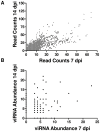RNAi targeting of West Nile virus in mosquito midguts promotes virus diversification
- PMID: 19578437
- PMCID: PMC2698148
- DOI: 10.1371/journal.ppat.1000502
RNAi targeting of West Nile virus in mosquito midguts promotes virus diversification
Abstract
West Nile virus (WNV) exists in nature as a genetically diverse population of competing genomes. This high genetic diversity and concomitant adaptive plasticity has facilitated the rapid adaptation of WNV to North American transmission cycles and contributed to its explosive spread throughout the New World. WNV is maintained in nature in a transmission cycle between mosquitoes and birds, with intrahost genetic diversity highest in mosquitoes. The mechanistic basis for this increase in genetic diversity in mosquitoes is poorly understood. To determine whether the high mutational diversity of WNV in mosquitoes is driven by RNA interference (RNAi), we characterized the RNAi response to WNV in the midguts of orally exposed Culex pipiens quinquefasciatus using high-throughput, massively parallel sequencing and estimated viral genetic diversity. Our data demonstrate that WNV infection in orally exposed vector mosquitoes induces the RNAi pathway and that regions of the WNV genome that are more intensely targeted by RNAi are more likely to contain point mutations compared to weakly targeted regions. These results suggest that, under natural conditions, positive selection of WNV within mosquitoes is stronger in regions highly targeted by the host RNAi response. Further, they provide a mechanistic basis for the relative importance of mosquitoes in driving WNV diversification.
Conflict of interest statement
The authors have declared that no competing interests exist.
Figures





References
-
- Ebel GD, Carricaburu J, Young D, Bernard KA, Kramer LD. Genetic and phenotypic variation of West Nile virus in New York, 2000–2003. Am J Trop Med Hyg. 2004;71:493–500. - PubMed
-
- Moudy RM, Meola MA, Morin LLL, Ebel GD, Kramer LD. A newly emergent genotype of west Nile virus is transmitted earlier and more efficiently by Culex mosquitoes. Am J Trop Med Hyg. 2007;77:365–370. - PubMed
Publication types
MeSH terms
Substances
Grants and funding
LinkOut - more resources
Full Text Sources

